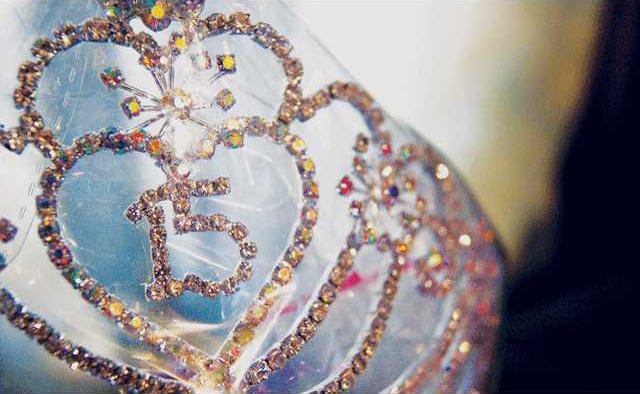Editor’s note: This is the first of two stories about the tradition of quinceañera in the Hispanic community.
When the weather begins to warm up, quinceañera season has arrived, and Great Bend photographer Javier Alvarez can be found on assignment any given Saturday. For a 15-year-old girl of Hispanic decent, the quinceañera is not only a birthday party; it’s a coming of age ceremony acknowledging a young woman’s transition from girlhood, in which she takes her place in the adult community, along with the responsibilities to her family and community that are expected of her. It’s a day full of tradition and fun that families and friends go to great expense and trouble to celebrate.
Alvarez has found a niche photographing the events of this day in the lives of Great Bend and area teens and their families. “I like my customers to relax and have fun while we’re shooting,” he said. He has developed an eye for the touching photos that give a glimpse into the intimate lives of his subjects, like Laura Leyva.
Luyva, a Great Bend teen, and her family recently celebrated her quinceañerra on June 9, and though most aspects of her life are still the same, she admits she feels more mature now, and ready to meet more adult expectations from her family.
“We started planning in January, but I’ve always known I would have a quinceañera,” she said. “It’s something me and my mother have talked about over the years, and I’ve always known it was in her future.” Laura translates for her mother, also named Laura. She said she began dreaming about her quinceañera when her daughter was born. Originally from Mexico, Mrs. Leyva said she did not have one, and her daughter believes it is more common in Great Bend than in her mother’s home town.
“In Mexico, it depends on the culture. It’s a lot like the American’s ‘Sweet 16’ party,” her mother said.
The ceremony itself is steeped in Mexican culture, going back to a time when Aztecs ruled the land, and the Spaniards had not yet stepped foot in the New World.
“This celebration is to change from being a little girl to being a woman,” Alvarez said. “It goes all the way back to the time of the Aztecs, back before the Spanish, when we were all true Mexicans. Back in those days, girls were sent away when they were young to be trained, and when they were 15, they would return to their family and would then be presented to the community so they could get married.”
Later, when the Spanish arrived, Alvarez said, in order to spread Catholicism, priests began mixing elements of religion into the ceremony, and bits of Spanish and French culture were also incorporated.
Father Don Bedore with Prince of Peace Parish in Great Bend confirms this. The church has a practice called enculturation, which acknowledges good elements of a native culture, and finds ways to incorporate them into the faith, and that is what happened with the quinceañera, he said.
“There is an acknowledgement of growth into maturity and adult womanhood, a spiritual being, and God blesses this growth and the process and the woman,” Father Bedore said. “The celebration is not a Catholic practice. It is a secular ceremony, but it has become a custom for the girls to come to the church for a blessing.”
In Great Bend, when the family would like to have a quinceañera blessed by a priest, they notify the church six months in advance. Each candidate must have received the three sacraments of baptism, communion and confirmation. A retreat is planned, and the girls spend an entire day learning about the spiritual importance of different aspects of the ceremony, and allowing God into their life, Bedore says.
“We discuss not only their position with family, friends and in the community, but also in the church,” he said. “As they grow and become more mature, these young women will have that spiritual undergirding that will allow them to pass on their faith to the next generation.”
The ceremony consists of the liturgy of the word, the processional entry, and then La Quinceañera makes a prayer of dedication.
“The most touching part of the ceremony for me was when I presented flowers to the Virgin Mary,” Leyva said.
Then, Father Bedore makes a prayer of blessing. Gifts are presented for blessing too, Alvarez said. The girl will receive a necklace with a religious medal, which signifies her decision to continue in the faith, and a ring that signifies she is with God. A contribution from the French and Spanish influence, a tiara is blessed, signifying that she is a person of high class. But that isn’t all.
“She gets a Bible, to remind her she needs to read it and take its teachings to heart, and flowers that are a symbol of her youthful beauty, and a reminder that she is like a flower,” Alvarez said. “Earrings are a new thing. They are to remind her to listen to God and her elders.”
Scheduling the ceremony six months in advance is also important. Quinceañeras have been known to be done as a separate Mass, or in the context of the regular weekend Mass in some places. But Bedore says in Great Bend, it is usually a separate ceremony, and most occur on Saturdays, which puts them in competition with weddings.
“There are probably actually at least as many or more quinceañera ceremonies performed than weddings in this area in a year’s time,” he said. Since coming to Prince of Peace Parish a year ago, he has performed between 12 and 15 blessings.
And like a wedding day, the quinceañera consists of more than just a religious ceremony. In part two, we’ll take a look at the traditions and the party.
MORE THAN JUST A BIRTHDAY PARTY
Hispanic tradition of Quinceaera celebration marks spiritual turning point for young women





